These Moons Are Dark and Frozen. So How Can They Have Oceans?
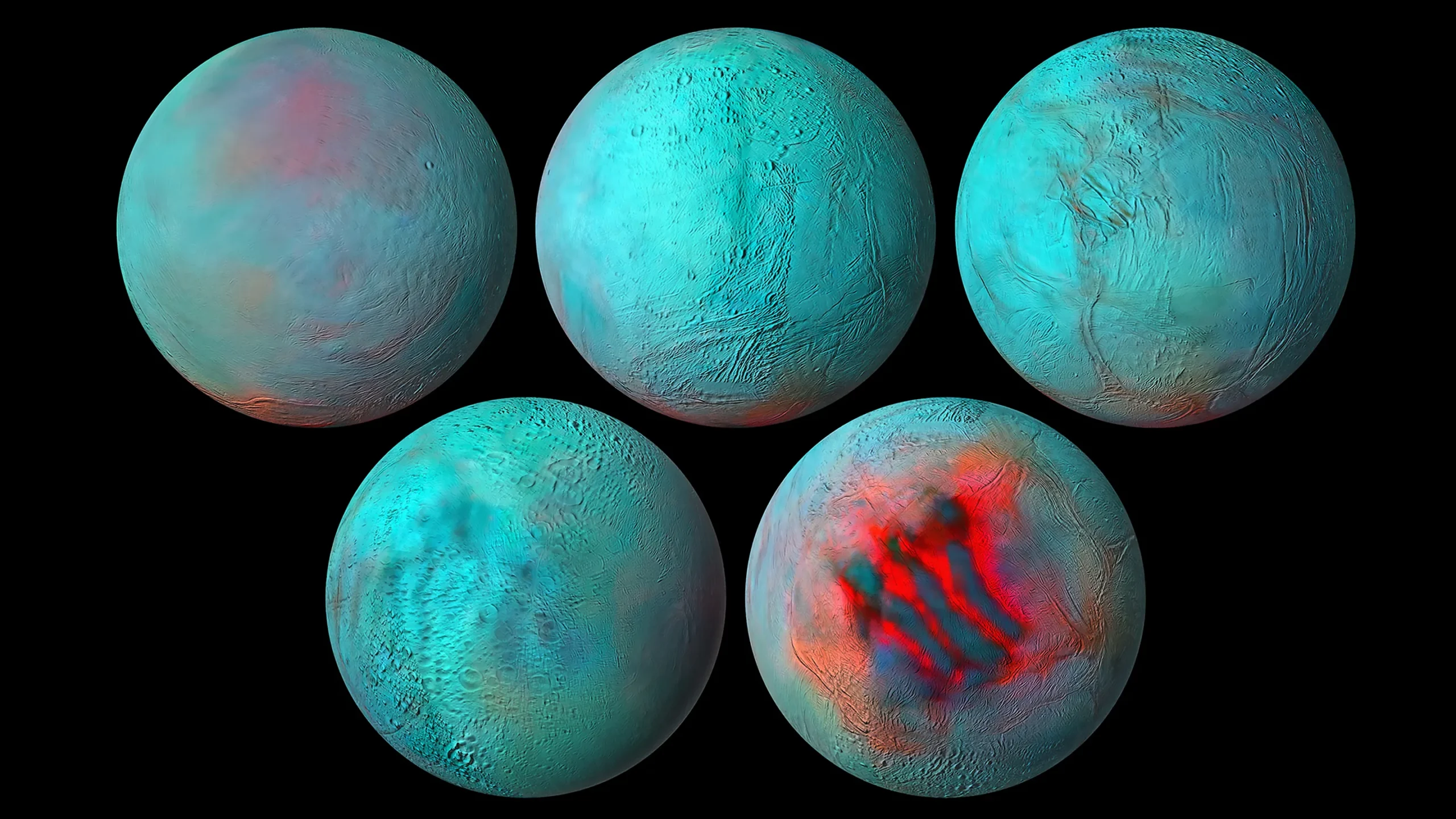
Five images of Saturn’s moon Enceladus, seen in infrared light. Nestled beneath its icy shell is a global ocean — a sea that is erupting into space through fractures in the moon’s south pole, colored red at bottom right.
NASA/JPL-Caltech/University of Arizona/LPG/CNRS/University of Nantes/Space Science Institute
Introduction
For most of humankind’s existence, Earth was the only known ocean-draped world, seemingly unlike any other cosmic isle.
But in 1979, NASA’s two Voyager spacecraft flew by Jupiter. Its moon Europa, a frozen realm, was decorated with grooves and fractures — hints that there might be something dynamic beneath its surface.
“After Voyager, people suspected that Europa was weird and might have an ocean,” said Francis Nimmo, a planetary scientist at the University of California, Santa Cruz.
Then, in 1996, NASA’s Galileo spacecraft passed by Europa and detected a strange magnetic field coming from within. “We didn’t understand what it was,” said Margaret Kivelson, a space physicist at the University of California, Los Angeles who was in charge of the spacecraft’s magnetometer. Eventually, she and her team realized that an electrically conductive fluid — something inside the moon — was convulsing in response to Jupiter’s immense magnetic field. “The only thing that made any sense,” Kivelson said, “was if there was a shell of liquid melt beneath the surface of the ice.”
In 2004, NASA’s Cassini spacecraft arrived at Saturn. When it observed Saturn’s small moon Enceladus, it found coruscating icy plumes erupting from vast chasms at the moon’s south pole. And when Cassini flew through these spouts, the evidence was unmistakable — this was a salty ocean vigorously bleeding into space.
Now Earth’s oceans are no longer unique. They’re just strange. They exist on our planet’s sunlit surface, while the seas of the outer solar system are tucked beneath ice and bathed in darkness. And these subterranean liquid oceans seem to be the rule for our solar system, not the exception. In addition to Europa and Enceladus, other moons with ice-covered oceans almost certainly exist as well. A fleet of spacecraft will explore them in detail over the next decade.
All of this raises an apparent paradox. These moons have existed in the frosty reaches of our solar system for billions of years — long enough for residual heat from their creation to have escaped into space eons ago. Any subsurface seas should be solid ice by now. So how can these moons, orbiting so far beyond the sun’s warmth, still have oceans today?
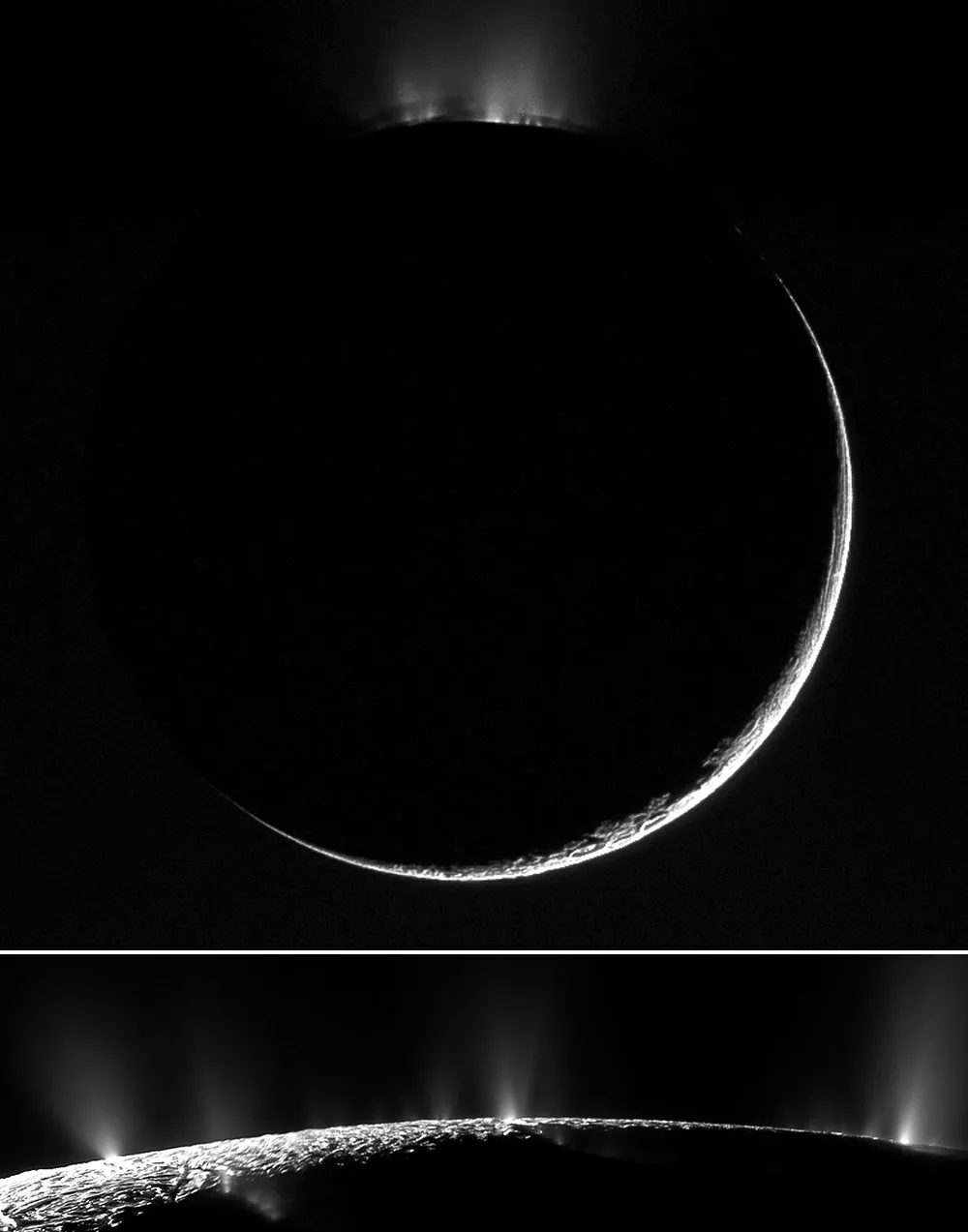
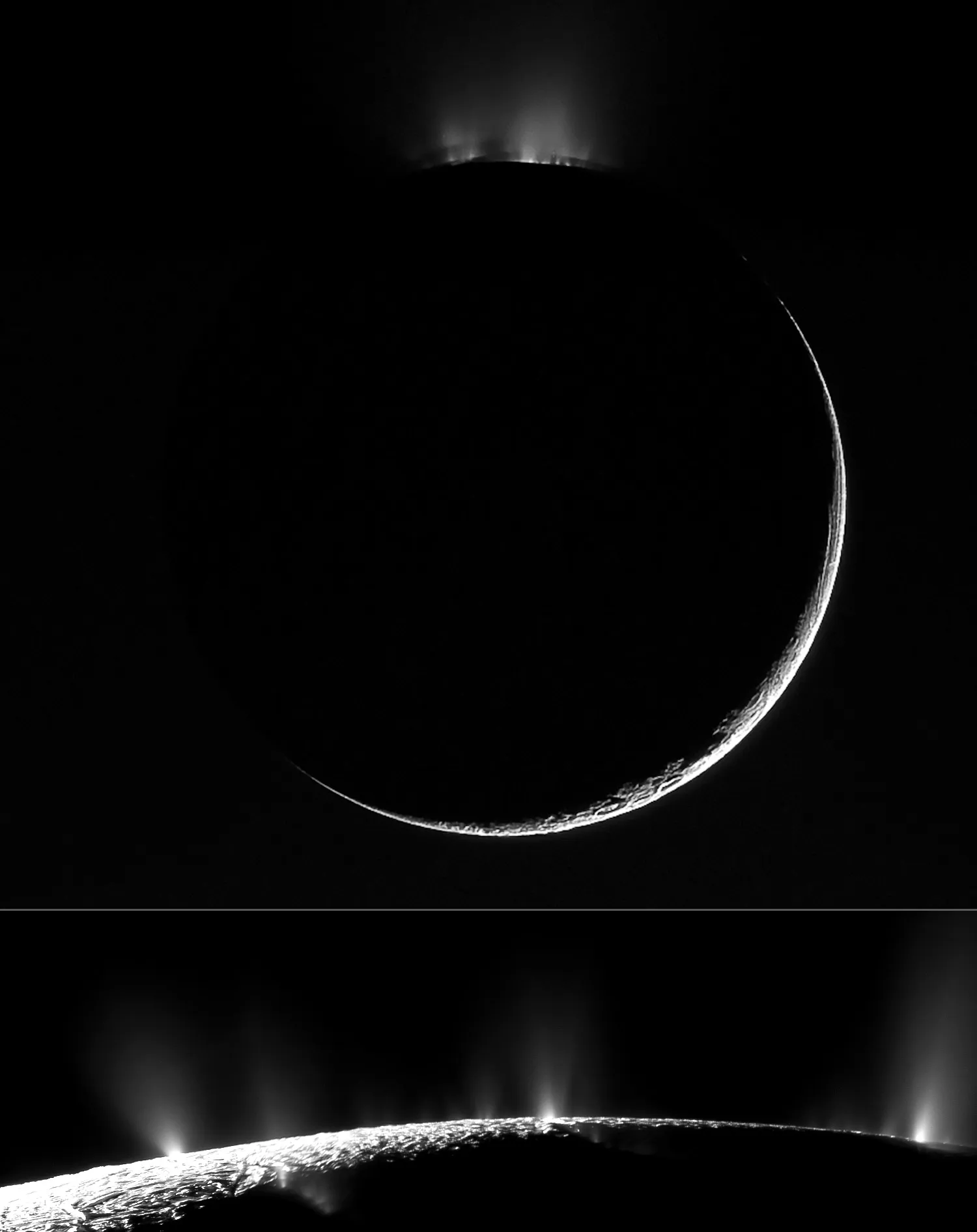
Saturn’s small moon Enceladus is spraying its saltwater ocean into space. The plumes, as seen by NASA’s Cassini spacecraft, surprised scientists with their ferocity.
NASA/JPL-Caltech/SSI/CICLOPS/Kevin M. Gill
Mounting evidence indicates that there may be multiple ways to sustain liquid-water oceans over billions of years. Decoding those recipes could accelerate our quest to determine how easy, or troublesome, it is for life to emerge throughout the cosmos. Freshly analyzed data from old spacecraft, plus recent observations by NASA’s Juno spacecraft and the James Webb Space Telescope, are adding to the growing evidence that these warm oceans contain chemistry beneficial to biology, and that the inner solar system is not the only place life could potentially call home.
These oceanic moons also offer a grander possibility. Temperate, potentially livable oceans could be an inevitable consequence of planet formation. It may not matter how far a planet and its moons are from their star’s nuclear bonfire. And if that’s true, then the number of landscapes we might explore in our search for life beyond Earth is nearly limitless.
“Oceans under icy moons seem weird and improbable,” said Steven Vance, an astrobiologist and geophysicist at NASA’s Jet Propulsion Laboratory.
And yet, defiantly, these alien seas remain liquid.
A Mirror-Wrapped Ocean
Scientists suspect that a handful of moons orbiting Jupiter and Saturn — and maybe even some spinning around Uranus and Neptune — harbor oceans. Hefty Ganymede and crater-scarred Callisto produce weak, Europa-like magnetic signals. Saturn’s haze-covered Titan, too, very probably has a liquid-water subsurface ocean. These “are the five that most scientists in the community feel pretty confidently about,” said Mike Sori, a planetary scientist at Purdue University.
So far, the only absolute oceanic certainty is Enceladus. “That’s a no-brainer,” said Carly Howett, a planetary scientist at the University of Oxford.
In the 1980s, some scientists suspected Enceladus had plumes; Saturn’s E ring was so clean and shiny that something — perhaps from one of its moons — must be leaking into space and constantly refreshing it. After Cassini finally witnessed that planet-garnishing magic in action, scientists briefly questioned whether the moon’s south-polar plumes might be the work of sunlight vaporizing ice in the moon’s shell — a bit like dry ice boiling away when heated, perhaps by sunlight.
“For a while, there was this argument about whether there needed to be an ocean at all,” Nimmo said. “What really nailed that was when [Cassini] flew through the plume and they found salt — sodium chloride. That’s an ocean.” There was still a chance that these plumes could be erupting from a smaller, more isolated sea. But further Cassini observations revealed that Enceladus’s shell is rocking back and forth so acutely that it must be separated from the moon’s deeper interior by a global ocean.
The plumes also pump out hydrogen and quartz, signs of deep-sea hydrothermal vent activity, said Frank Postberg, a planetary scientist at the Free University of Berlin. On Earth, such vents produce the heat and chemistry needed to power ecosystems that exist beyond the reach of sunlight — communities of organisms that scientists once thought could not exist in our photosynthetically dependent world.
But what could be powering a vent system strong enough to heat an entire ocean? Another moon — this one of the fiery variety — would provide those clues.
The Eternal, Infernal Tides
In June 1979, a month before Voyager 2’s close flyby of Europa, scientists announced that Voyager 1 had glimpsed titanic, umbrella-shaped plumes billowing into space above Io — the eruptive fingerprints of several volcanoes.
This observation should have been baffling: Volcanism requires an internal heat source, and Io, like the other icy moons, should have been nothing more than embers. But a few months earlier, an independent team of scientists had correctly predicted that Io might be a hyperactive volcanic world.
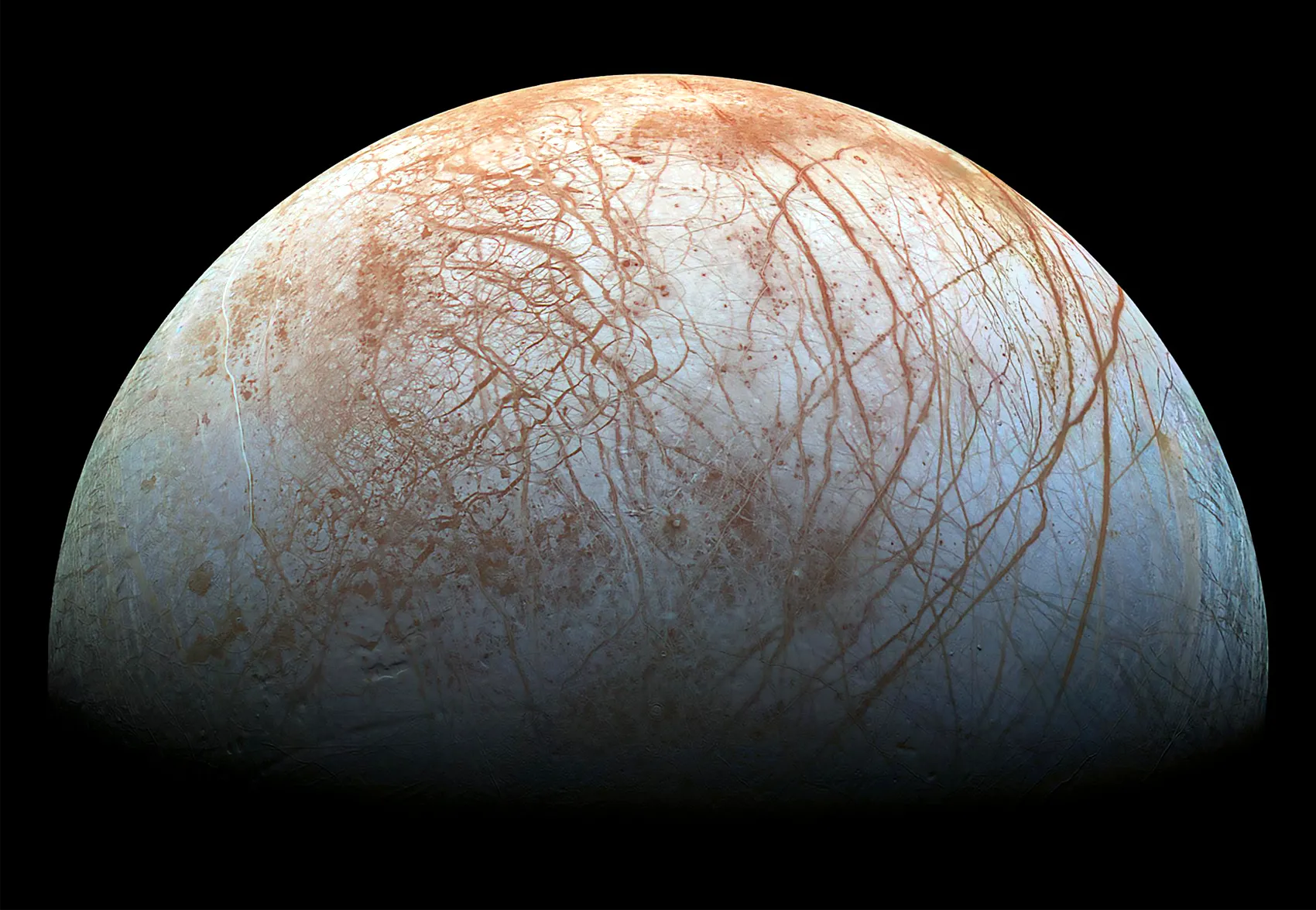
Two upcoming space missions will study Jupiter’s moon Europa, considered one of the best places to look for alien life in the solar system. The spacecraft will characterize the moon’s surface and the sea that’s thought to hide beneath its icy crust.
NASA/JPL-Caltech/SETI Institute
They’d based their prediction on the orbital dance of Jupiter’s largest moons. For every four orbits that Io completes, Europa makes two and Ganymede one. This orbital configuration, known as a resonance, causes Io to wobble back and forth, making its orbit elliptical. When Io is closer to Jupiter, the planet’s gravity yanks on it more intensely. When it’s farther away, Jupiter’s tug is weaker. That never-ending gravitational tug-of-war makes the rocky surface of Io move up and down by 100 meters, the same height as a 30-story building. These are tides, like Earth’s — just in solid rock, not water.
Those tides create friction within the moon that generates heat. And that tidal heating is strong enough to melt the rock deep inside Io. “Io doesn’t have a water ocean, but it probably has a magma ocean,” Nimmo said. (Galileo picked up on a secondary magnetic field there too, generated by a global subterranean reservoir of molten rock.)
Europa also experiences some tidal heating. But how much those tides warm an ocean depends on where within the moon they occur; in other words, enough of that heat needs to get to the ocean to keep it liquid. “The tidal heating could be happening in the ice shell itself, or it could be happening in the rocky core underneath,” Nimmo said. Scientists don’t know which is correct — so they can’t say for sure how much tidal heating contributes to Europa’s liquid interior.
Enceladus, too, is stretched and squeezed by its gravitational tango with a neighboring moon called Dione. In theory this could produce tides that warm the moon’s interior. But the tides created by its resonance with Dione, at least on paper, do not seem to be sufficient to explain its ocean. The numbers don’t yet work, Sori said, and the amount of heat produced isn’t enough to maintain a global ocean for the billions of years since the solar system’s birth. Perhaps, as with Europa, scientists don’t quite know where the tides are creating heat within Enceladus.
Another confounding factor is that orbits aren’t fixed over astronomical time. As planetary systems evolve, moons migrate, and “tidal heating can turn on and off as things drift in and out of different resonances,” said David Rothery, a planetary scientist at the Open University in the United Kingdom. Scientists suspect this happened with Miranda and Ariel, two Uranian satellites that may be former dance partners; these moons look as if they were once geologically active but are now arguably frozen to their cores.
Merrill Sherman/Quanta Magazine; source: NASA
In a similar vein, Enceladus may not always have had Dione as its dance partner: Perhaps their Saturn-circling boogie kicked off more recently and warmed a previously solid moon. But that scenario is also troublesome to explain. “It’s easier to keep an ocean around and maintain it, rather than freeze and remelt it,” Sori said. Thus, if tidal heating is exclusively responsible for Enceladus’s ocean, then the moon is a veteran dancer that has bopped for several billion years.
For now, the only certainty about this moon’s ocean is that it exists. How it came to be, and how it’s still around today, “is one of the really big unsolved questions,” Sori said. “Enceladus is tough to figure out.”
Radioactive Renegades
Fortunately, warm moony interiors don’t exclusively depend on tides.
Half of Earth’s internal heat came from its birth. The rest comes from decaying radioactive elements. Similarly, the rock-rich depths of icy moons should contain a decent amount of uranium, thorium and potassium — radioactive stores that can cook their surroundings for hundreds of millions, if not billions, of years before they decay into stable elements and stop releasing heat.
Bigger moons will have started out with more bountiful caches of radioactive matter. And perhaps that is all their oceans require. “For larger moons like Ganymede and Callisto and Titan, they’re sort of inevitable because of this radiogenic factor,” Vance said. Some scientists even argue that Pluto has a subsurface ocean. Like the three moons, this dwarf planet is likely insulated by a sufficiently thick crust that slows the leaking of its radioactive furnace into space.
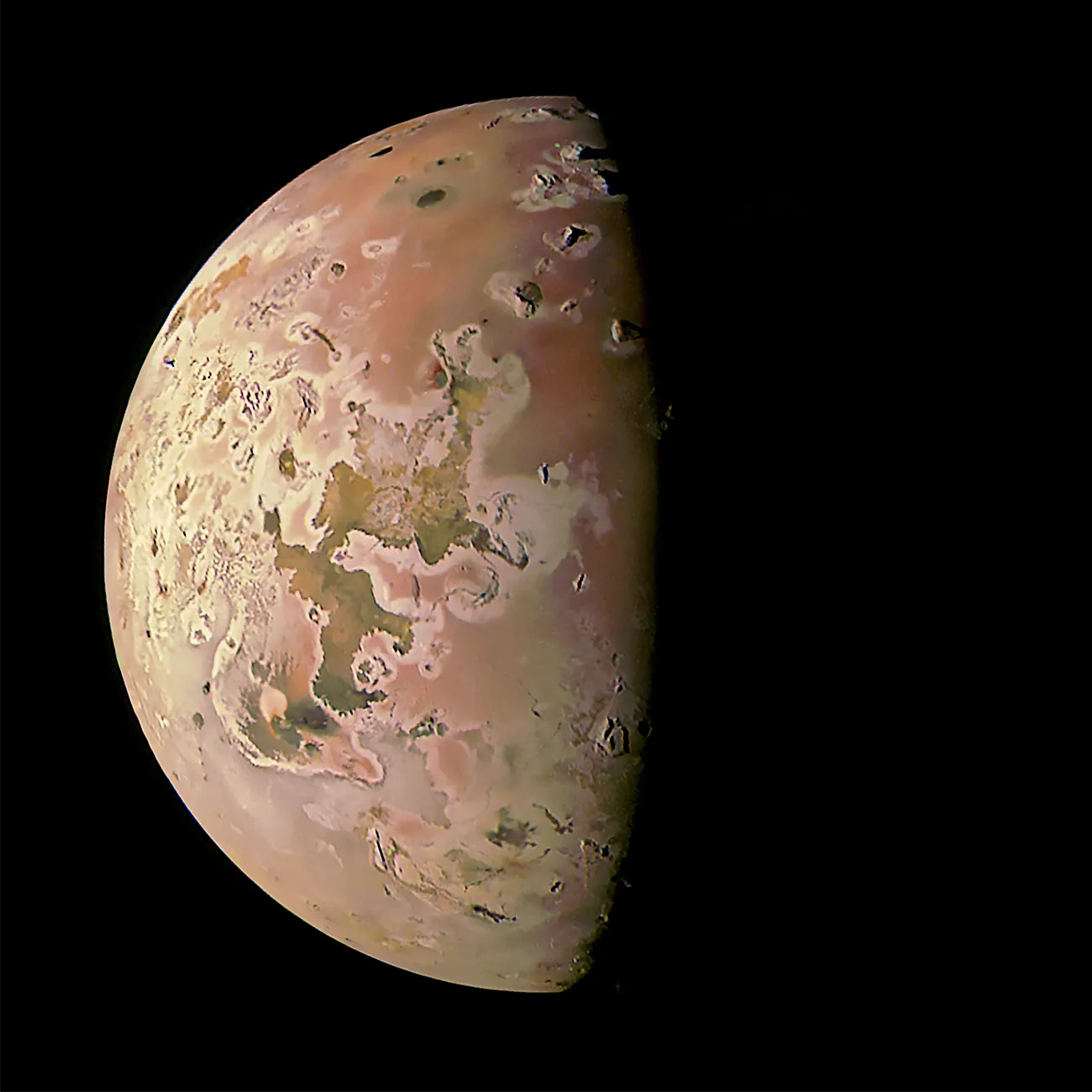
The most volcanic body in the solar system, Jupiter’s moon Io offers some clues to how icy ocean worlds might maintain their liquid interiors.
NASA/SwRI/MSS/Ted Stryk
Yet the relatively small hearts in Lilliputian moons like Enceladus don’t contain enough radioactive matter to keep them toasty for billions of years. One unsatisfactory resolution to this conundrum is that maybe Enceladus just got lucky: Radioactivity could explain an early portion of its oceanic past, and its dance with Dione a more recent episode. Maybe “we’re now at the point of crossover, where the radiogenic [heating] gets so low that the tidal heating takes over,” Postberg said.
If so, perhaps Enceladus is a microcosm of the universe: a serendipitous combination of tidal heating and radioactivity. That would mean that oceanic moons could exist everywhere — or, conversely, almost nowhere.
Youthful Oceans
Alternatively, and controversially, some scientists argue that Enceladus could be remarkably young.
Hiding in the reams of data gathered by the Cassini spacecraft are hints that Saturn wasn’t born with its iconic rings. Instead, many scientists are now convinced that the rings formed just a few hundred million years ago. New research using supercomputers to simulate moon-on-moon violence suggests that Saturn’s rings formed when two ancient moons collided around the time that stegosaurs roamed the Earth. This smashup littered Saturn’s orbit with legions of icy shards; while many formed the rings, others busted up existing moons and created new ones. And if the rings are young, Enceladus and a handful of other moons might be young too.
Merrill Sherman/Quanta Magazine; source: NASA
“It feels like people are becoming more open to considering that the moons are young,” said Jacob Kegerreis, a research scientist at NASA’s Ames Research Center in Mountain View, California, and a co-author of the recent ring formation study.
In a twist that supports this idea, it turns out that scientists don’t know how old some of Saturn’s moons are. “Enceladus could be only a few hundred million or tens of millions of years old,” Rothery said. If so, then the heat from its frenzied birth may still be keeping its young ocean liquid.
But the young-moons story is far from certain — the sheer number of craters many display suggests that the moons have been around to experience the solar system’s pinball-like pandemonium for many an eon. “I do think, in the Saturn system, something bizarre happened a few hundred million years ago,” Nimmo said. “But my guess is that all the satellites are 4.5 billion years old.”
Satellite Soothsayers
With the Galileo and Cassini missions long dead, scientists are now pinning their hopes on two spacecraft: the European Space Agency’s Jupiter Icy Moons Explorer, which recently launched, and NASA’s Europa Clipper, which has not. Both will arrive at Jupiter at the start of the next decade.
And that brings us back to Europa, the moon that first forced a reimagining of the cosmic context in which Earth’s seas exist.
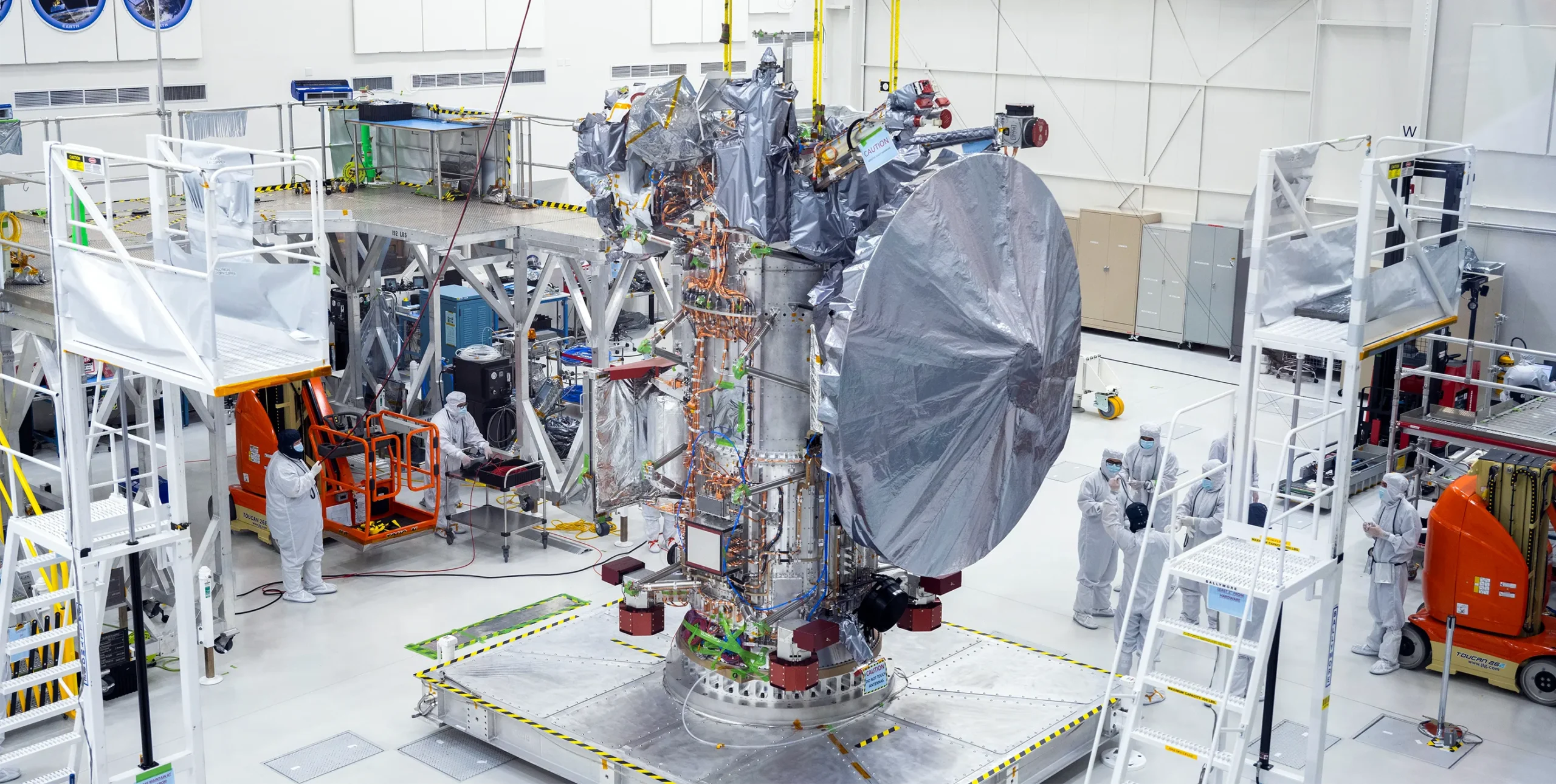
NASA’s Europa Clipper spacecraft, currently being assembled at the Jet Propulsion Laboratory, will launch for Europa in 2024.
NASA/JPL-Caltech
One of the goals for the Clipper spacecraft — set to fly in October 2024 — is (in the words of the mission’s objective list) to “confirm” that Europa’s ocean exists. “There were a lot of arguments about that word,” Nimmo said. Clipper could find something other than an ocean; there may instead be a frozen sea filled with pockets of meltwater. Or “it could be a thin layer of gold,” Nimmo joked. “I think it’s 99% sure there’s an ocean there.”
Assuming that Clipper confirms the existence of Europa’s ocean, it will get to work characterizing the moon and its subsurface sea. To do that, the spacecraft will start by figuring out which molecules are on the moon’s surface — and, if scientists are lucky, in the ocean below. As it flies by the moon, Clipper will ingest any microscopic dust, ice or water vapor wafting off the moon’s surface. Those particles will be studied by its surface dust analyzer instrument: As grains hit its metal plate, they are vaporized and electrically charged, allowing the instrument to unveil the chemical identity of the grain.
The hope is that plumes are gently venting Europa’s ocean into space, which would make Clipper’s quest considerably easier. Such spouts may exist, but they won’t be like those of Enceladus; they may be more intermittent and geographically sporadic. Or they may not be present at all — in which case, the hope is that micrometeorite impacts may be chipping away at the icy shell, liberating soupçons of the ocean and spraying it toward Clipper.
And it might turn out that when it comes to staying warm, Europa and the other moons rely on chemical tricks that are not as alien as we might expect. In winter, “we salt the roads to lower the melting temperature,” Sori said. Maybe Europa’s ocean is especially salty, which would lower the freezing point. Other compounds would be more effective antifreeze, though — “ammonia, in particular,” Sori said, which is more abundant farther from the sun’s vaporizing glare.
Tides, radioactivity, chemistry and youth: These ingredients, when mixed in the right way, can produce — and sustain — oceans on these icy moons. “With all these things, I don’t think it’s either/or,” Howett said. The specific recipe for each satellite might be different. There could be hundreds of ways to make an ocean-filled icy moon.
The discovery of Europa’s secret ocean “really did change the way people thought about moons,” Kivelson said. And it set science on a course to determine if alien life forms might populate these alien seas, and perhaps bring about a discovery that will forever alter our conception of our place in the universe.



